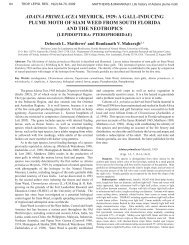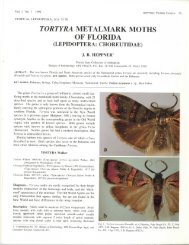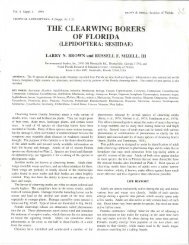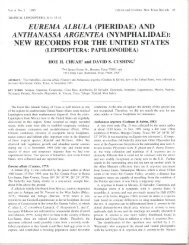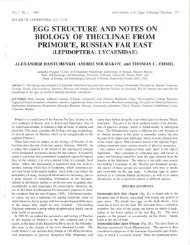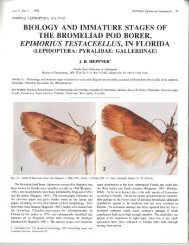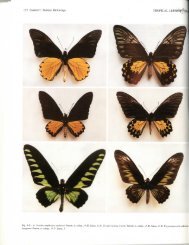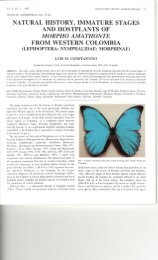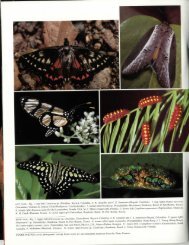butterfly photography in morocco - Association for Tropical ...
butterfly photography in morocco - Association for Tropical ...
butterfly photography in morocco - Association for Tropical ...
You also want an ePaper? Increase the reach of your titles
YUMPU automatically turns print PDFs into web optimized ePapers that Google loves.
14 KRIZEK: Morocco butterflies TROPICAL LEPIDOPTERAFig. 1. Zerynthia rum<strong>in</strong>a ornatiorFig. 2. Euchloe ausonia crameriFig. 3. Zegris eupheme meridional'isFig. 4. Colotis evagore nounaFig. 5. Anthocharis belia beliaFig. 6. Gonepteryx deopatra
Vol. 1 No. 1 1990 Morocco butterflies: KRIZEK 15Fig. 7. Pandoriana pandora, 9Fig. 8. Pandoriana pandora, t?Fig. 9. Pandoriana pandora, 9Fig. 10. Melanargia <strong>in</strong>esFig. 11. Melitaea aetherie, 9Fig. 12. Melitaea aetherie,
16 KRIZEK: Morocco butterflies TROPICAL LEPIDOPTERAFig. 13. Eupkydryas desfontatnitFig. 14. Azanus jesousFig. 15. Euphydryas desfonta<strong>in</strong>iiFig. 16. Glaucopsyche melanops,
Vol. 1 No. 1 1990 Morocco butterflies: KRIZEK 17\905JIyponephele marrocana Blachicr l90S,Nordmanniaesculimauretanica Staud<strong>in</strong>gcr 1892, Plebicula ailantica Elwes 1905,Pseudochazara atlantis Ausiaut 1905, and Thersamonia phoebusBlachicr 1908. I was able to photograph two of these species(see the color plates).When collect<strong>in</strong>g <strong>in</strong> the Moroccan mounta<strong>in</strong>s, one has to useone's "entomological <strong>in</strong>st<strong>in</strong>ct" to locate butterflies. They are notalways to be found <strong>in</strong> the vic<strong>in</strong>ity of the creeks, as expected <strong>in</strong>the tropics. On the contrary, one often f<strong>in</strong>ds them on very dryhot schist slopes or gorges. Pierids are usually not far from theirlarval food plants, and adults often spend the nigh percheddirectly on the blossoms (e.g., note the cryptic coloration ofZegris eupheme <strong>in</strong> the color plates). In the lowlands, however,the entomologist's attempts are usually not rewarded, unless onef<strong>in</strong>ds a well irrigated field of lucerne (Medicago). In such places,one is lucky to f<strong>in</strong>d abundant Lycacnidac and Picridae.In Marrakech, the greatest number of butterflies is found <strong>in</strong> thegardens (palm groves) on the north-east marg<strong>in</strong>s of the city,beh<strong>in</strong>d the city <strong>for</strong>tifications <strong>in</strong> the vic<strong>in</strong>ity of Bab-el-Khcmis. Itis best to go there via taxi cab. In that area, dangerous unexpectedholes <strong>in</strong> the sandy-gravel terra<strong>in</strong> of about 4 m diameter and 6m or 8 m deep should be avoided. These holes look like giantcone-shaped pits of ant lion larvae, but the walls are morevertical, which would make climb<strong>in</strong>g out very difficult orimpossible. The orig<strong>in</strong> of these holes is unknown to me. A verypa<strong>in</strong>ful death of dehydration would await a person trapped <strong>in</strong>side.It would be beyond the scope of this article to try to mention allof the <strong>butterfly</strong> species which I collected or observed <strong>in</strong> Morocco.There<strong>for</strong>e, I would like to describe my observations and listrecords <strong>for</strong> only those 21 species which I photographed andwhose illustrations acompany this article. The type locality (TL)<strong>for</strong> each species or subspecies described from Morocco is<strong>in</strong>cluded.1. PAPILIONIDAEZerynthia rum<strong>in</strong>a ornatior Blachier, 1905 Fig. 1TL: Morocco. Larval food plant, Aristolochia. Ifrane, 7 May1987.2. PIERIDAEAnthocharis belia belia L<strong>in</strong>naeus, 1767 Fig. 5Male. TL: "Barbaria," i.e., Morocco. Larval food plant,Biscutella lyrata. Ifrane, 8 May 1987.Colotis evagore nouna Lucas, 1849 Fig. 4Larval food plant, Capparis. Flies <strong>in</strong> very hot and drymounta<strong>in</strong> gorges, both on schist as well as limestone terra<strong>in</strong>.Asni, Moulay-Brahim, 22 June 1982.Euchloe ausonia crameri Butler, 1869 Fig. 2Larval food plant, Cruciferae. Ifrane, 5 May 1987.Gonepteryx cleopatra cleopatra L<strong>in</strong>naeus, 1767 Fig. 6Male. Ifrane, 8 May 1987.Zegris eupheme meridionals Lederer, 1852 Fig. 3Larval food plant, S<strong>in</strong>apis <strong>in</strong>cana. Note the cryptic resemblanceto the plant <strong>in</strong> the photograph. This specimen was photographed<strong>in</strong> its roost<strong>in</strong>g position after sunset. Ifrane, 6 May 1987.3. NYMPHALIDAEEuphydryas desfonta<strong>in</strong>ii desfonta<strong>in</strong>ii Godart, 1819 Fig. 13-15Larval food plant, Knautia. Ifrane, 8 May 1987.Melanargia <strong>in</strong>es Hoffmannsegg, 1804 Fig. 10Asni, Moulay-Brahim, schist-limestone contact zone. 22 June1982.Melitaea aetherie algirica Ruhl, 1892 Fig. 11-12Ifrane, 6 May 1987.Pandoriana pandora Denis & Schiffermiiller, 1775 Fig. 7-9One of the largest Moroccan butterflies. In Ifrane (7 May1987), I saw only one specimen. My pictures are from AsiaM<strong>in</strong>or, Sultan Dagi Mounta<strong>in</strong> (also limestone), where this<strong>butterfly</strong> was abundant on 19 July 1988, at 2000m. Larval foodplants are violets.4. LYCAENIDAEAricia cramera Eschscholtz, 1821 Fig. 25-26Ifrane, 8 May 1987.Azanus jesous Guer<strong>in</strong>, 1849 Fig. 14Larval food, Acacia, perhaps also Medicago. Flies aroundMimosa bushes, also nectar<strong>in</strong>g at Medicago. Marrakech, 10 May1987.Cupido lorqu<strong>in</strong>i Hcrrich-Schaffer, 1847 Fig. 27Male. Ifrane, 8 May 1987. Dry Cedar-Ilex-Oak scrub, thesame locality as A. belia belia.Glaucopsyche melanops algirica Heyne, 1895 Fig. 16Male. High Atlas, 1700 m. 12 May 1987. Vic<strong>in</strong>ity of tallbroom. Small, very steep dry schist valley with m<strong>in</strong>iature spr<strong>in</strong>g.Several specimens were patrol<strong>in</strong>g up and down the valley,sometimes imbib<strong>in</strong>g water from the wet stones, but also nectar<strong>in</strong>gat yellow flowers of a species of Cruciferae.Lysandra punctifera Oberthiir, 1876 Fig. 19-20Male. Ifrane, 6 May 1987. Flies on dry limestone semiaridareas, together with A. cramera, P. abencerragus, E. ausoniacrameri and M. aetherie.Nordmannia esculi mauretanica Staud<strong>in</strong>ger, 1892 Fig. 29TL: Morocco. This specimen was photographed <strong>in</strong> the HighAtlas at an altitude of around 1700m, <strong>in</strong> a dry Ilex-Oak mixedthorny scrub. In the afternoon hours, it was very common to f<strong>in</strong>dthis species lateral-bask<strong>in</strong>g and nectar<strong>in</strong>g. This species was notrecorded from High Atlas by Higg<strong>in</strong>s & Riley (1970). Note thatthe ventral side of both the <strong>for</strong>cw<strong>in</strong>g and the h<strong>in</strong>dw<strong>in</strong>g is almostwithout any mark<strong>in</strong>g, simply pale grayish brown, unlike N. ilicisl21 June 1982.Philotes abencerragus Pierret, 1837 Fig. 21-22TL: Morocco.Found <strong>in</strong> rough places around Erica arborea. I observed thisspecies <strong>in</strong> May <strong>in</strong> the Middle Atlas (Ifrane) and <strong>in</strong> June <strong>in</strong> theHigh Atlas (Asni, Moulay-Brahim). Found on both schist as wellas limestone terra<strong>in</strong>. Ifrane, 8 May 1987.Tarucus theophrastus Fabricius, 1793 Fig. 28TL: Morocco. Larval food plant, Zizyphus vulgaris (a verysp<strong>in</strong>y shrub). Butterflies usually fly around and "<strong>in</strong>side" the bush,where they also mate. Sometimes they are nectar<strong>in</strong>g on lucerne<strong>in</strong> the immediate vic<strong>in</strong>ity. As a rule, they sat with w<strong>in</strong>gs closed,so only the ventral side could be photographed. This pair <strong>in</strong>copula was photographed 24 June 1982 <strong>in</strong> Marrakech.Thersamonia phoebus Blachier, 1908 Fig. 23-24
18 KREEK: Morocco butterfliesTROPICAL LEPIDOPTERAFig. 19. Lysandra punctifera,
Vol. 1 No. 1 1990 Morocco butterflies: KREEK 19Kg. 25. Aricia cramera, 9 oviposit<strong>in</strong>gFig. 26. Aricia cramera, 9Fig. 27. Cupido lorqu<strong>in</strong>i,
20 KRIZEK: Morocco butterflies TROPICAL LEPIDOPTERATL: High Atlas, Morocco. This true Moroccan endemicspecies was observed by me <strong>in</strong> Marrakcch <strong>in</strong> June 1982 and aga<strong>in</strong><strong>in</strong> May 1987. I found it <strong>in</strong> the well-irrigated areas necuir<strong>in</strong>g onMedicago, and also fly<strong>in</strong>g very low among the vegetation of thewater-filled irrigation ditches. It behaves like a typical copper.Larval food plant, Rumex. Accord<strong>in</strong>g to Higg<strong>in</strong>s & Rilcy (1970),it is "conf<strong>in</strong>ed to the High Atlas <strong>in</strong> western Morocco." Marrakech,17 June 1982. Elevation around 550m.Zizeeria knysna Trimen, 1862 Fig. 17-18Larval food plant, Oxalis and Medicago. I observed it at thesame locality as T. phoebus, T. theophrastus and A. jesous,ncctar<strong>in</strong>g on Medicago. In contrast to T. phoebus, it wassometimes even several hundred meters away from moist places.It is very difficult to photograph, as a rule clos<strong>in</strong>g the w<strong>in</strong>gswhen be<strong>in</strong>g approached by the camera. Marrakech, 10 May1987.5. HESPERIIDAEI saw many hespcrids <strong>in</strong> Morocco, most of them of the"Pyrgus" type, and I also photographed several. Here, I amshow<strong>in</strong>g one species of the genus Carcharodus.Carcharodus boeticus standm Reverd<strong>in</strong>, 1913 Fig. 30I saw it primarily on hot and very dry schist slopes <strong>in</strong> the HighAtlas. Its cryptic coloration makes it <strong>in</strong>discernible from its background.This species is a close mimic of some day-fly<strong>in</strong>gNoctuids of the Autographa gamma group, which are abundant <strong>in</strong>the same localities. I never found C. boeticus itself to becommon or abundant. It is very shy, and hard to photograph. Iobserved it <strong>in</strong> the Asni and Moulay-Brahim area on 22 June1982. The accompany<strong>in</strong>g illustration shows Carcharodusboeticus (subspecific determ<strong>in</strong>ation unknown) which I photographed<strong>in</strong> Asia M<strong>in</strong>or, Sultan Dagi Mounta<strong>in</strong>s, at an elevation ofabout 2000 m, on limestone background, 22 July 1988.In conclusion, I would like to say that safety should be aconcern to an entomologist travell<strong>in</strong>g <strong>in</strong> Morocco. While thenomadic tribes (Bedou<strong>in</strong>es and Berbers) <strong>in</strong> the desert andmounta<strong>in</strong>s far from civilization are friendly people (be sure tohave a large supply of co<strong>in</strong>s, if you want to photograph children;without reward, they may become aggressive!), crime is flourish<strong>in</strong>g<strong>in</strong> the cities. The most professional, highly tra<strong>in</strong>ed crim<strong>in</strong>alsFig. 33. Jebel Torbkal, Masif Asni, High Atlas.wait <strong>for</strong> a tourist immediately <strong>in</strong>side or <strong>in</strong> front of his hotel.They usually work as a team of two men, one on a motorcyclewho will help to carry away the successful pickpocket. Try toavoid any people, especially on tra<strong>in</strong>s and buses, who will try,very politely but adamantly, to <strong>in</strong>volve you <strong>in</strong> a conversationsay<strong>in</strong>g that they are "students" who like to talk to <strong>for</strong>eigners totra<strong>in</strong> their language skills. Very soon, these "students" will ask<strong>for</strong> f<strong>in</strong>ancial reward, because the conversation was actually aservice of a "tourist guide" that provided you with a "lot of<strong>in</strong><strong>for</strong>mation." Or they will push you to go <strong>in</strong>to a particular hostelor hotel, whose manager is "their friend," and so <strong>for</strong>th. Innorthern Morocco, your car may be stopped far from civilizationby hashish peddlers, who want to sell hashish to you and willthreaten your personal safety if you refuse. It is better not to goto Morocco alone. Two or three persons, however, may feelfairly safe on an entomological expedition and have most<strong>in</strong>terest<strong>in</strong>g and stimulat<strong>in</strong>g collect<strong>in</strong>g and <strong>photography</strong> <strong>in</strong> thisfasc<strong>in</strong>at<strong>in</strong>g country.ACKNOWLEDGEMENTSI thank Dr. Jan Kut<strong>in</strong>a of The American University, Wash<strong>in</strong>gton,D.C., <strong>for</strong> his k<strong>in</strong>d help regard<strong>in</strong>g geological <strong>in</strong><strong>for</strong>mation andliterature perta<strong>in</strong><strong>in</strong>g to Morocco. I also wish to express mygratefulness to Monika Krizek <strong>for</strong> her editorial help on themanuscript.LITERATURE CITEDFig. 31-32. High Atlas foothill habitats.Anonymous.[Undated]. Editions du Sercie Geologique du Maroc. Rabat.Higg<strong>in</strong>s, L. G., and N. D. Rilcy.1970. A field guide to the butterflies of Brita<strong>in</strong> and Europe. Boston:Houghton Miffl<strong>in</strong>. 580 pp, 60 pi.MR-hard, A.1976. Elements de Geologic Maroca<strong>in</strong>e. Notes Mem. Service Geol.(Rabat), No. 252.Mokhlcs, A.1984. Calendar of the fly<strong>in</strong>g period of the Rhopalocera of Morocco.Nota Lepid. (Bonn), 7(3): 257-263.



